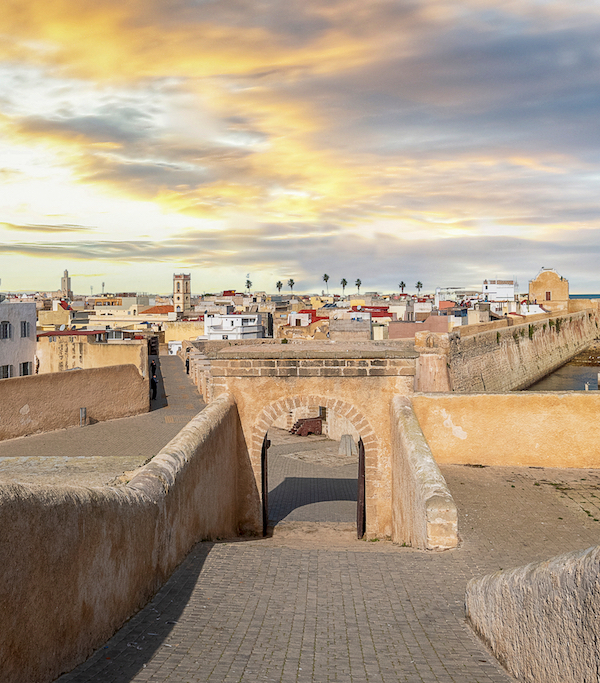Moroccan souks are an absolute paradise for food lovers, where every corner promises a new taste adventure. These bustling markets aren’t just about shopping; they’re overflowing with irresistible little dishes that make for the perfect snack between visits. Moroccan street food, often rooted in humble, popular traditions, boasts bold, fragrant flavors that have charmed even the pickiest of eaters.
In Morocco, food isn’t just sustenance—it’s practically a sacred ritual. Even in cities like Fez, known for its refined, intricate dishes tucked away in hidden riads, you can still find markets brimming with savory treats. These “ch’hiwates” are the kingdom’s secret delights, loved by locals and visitors alike. Each street offers something crispy, crunchy, and totally unforgettable. Ready to discover some of the best street food in Morocco?
Table of Contents
Harira
![5 Best Street Food In Morocco [And Top Places To Taste It] 6 Harira Best Street Food In Morocco](https://artandthensome.com/wp-content/uploads/2024/08/454207620_1039542701506945_2245708202525666879_n-1024x1024.jpg)
What is it ?
Harira is a traditional Moroccan soup, but it’s more than just a dish—it’s an experience. And it’s not just one soup; in fact, the term “harira” can refer to a variety of soups, both sweet and savory, that Moroccans enjoy. However, during the sacred month of Ramadan, there’s one particular harira that takes center stage. This special soup is served at dusk, right after the call to prayer that signals the ftour, the first meal to break the fast.
This savory harira is packed with ingredients that bring comfort and energy after a long day of fasting. Imagine finely diced beef or mutton, tomatoes, chickpeas, lentils, onions, and celery simmering together. Add vermicelli, and most importantly, a fragrant blend of ginger, saffron, and fresh coriander to create that signature aroma that makes harira unmistakable.
Where to Eat it?
- Jemaa El-Fna in Marrakech: Among the buzzing open-air restaurants, some stalls focus solely on harira, traditionally served with dates. It’s the perfect spot to savor it in an authentic setting.
- Essaouira: On Avenue Istiqlal, opposite the jewelers’ souk, grab a seat on a simple stool and let the timeless voice of Oum Kalthoum provide the soundtrack to your harira experience.
- Café des Épices in Marrakech: For a chic, bohemian twist, head to this café in the medina. Enjoy your harira while soaking in the vibrant view of Marrakech’s most colorful square.
Jemaa El Fna in Marrakech, every day from 5 p.m. Around 0.4 euros per bowl.
Café des Épices , Place Rahba Kdima in Marrakech, every day from 9 a.m. to 11 p.m. Around 2 euros.
Méchoui
![5 Best Street Food In Morocco [And Top Places To Taste It] 7 Mechoui Best Street Food In Morocco](https://artandthensome.com/wp-content/uploads/2024/08/165269082_446118736677005_1843555003784303913_n-1-820x1024.jpg)
What is it?
In Marrakech, indulging in a mechoui barbecue at the Ableuh souk is a cherished tradition for locals, especially those from Casablanca and Rabat, who flock there to enjoy this rustic yet festive meal. It’s more than just eating—it’s a communal experience. At most places, you buy your meat by the weight, then gather around a shared table. The freshly grilled mutton is served steaming hot on a simple paper plate, accompanied by salt, cumin, fresh bread, and of course, a glass of mint tea to complete the meal.
And if you’re still craving more? Look around, and you might see a large lid being lifted to reveal an oven where a whole sheep is slowly roasted to perfection. This is the barbecue oven, where the meat becomes so tender, it’s traditionally eaten Moroccan style—using just three fingers of the right hand. Not exactly a vegan’s paradise, but for those who want a plant-based snack, olives from a nearby stall make a great side.
There’s also tanjia, a must-try dish unique to Marrakech. It’s made with beef or mutton, mixed with preserved lemons and fragrant spices, all packed into a jar (also called the tanjia) and slow-cooked in a hammam oven. It takes time, but the result is melt-in-your-mouth deliciousness.
Where to Eat it ?
- Mechoui alley at the Ableuh souk: The fast turnover ensures the meat is always fresh and delicious.
- Ouazzani in Guéliz: In the new part of town, you can enjoy perfectly cooked mechoui and tanjia either on the terrace or in the quirky, kitsch dining room. A real treat for those looking to savor Marrakech’s finest.
Souk Ableuh, in Marrakech, open every day, from 10 a.m. to 2 p.m. Mechoui or tanjia at around 15 euros per kilo.
Chez Ouazzani. 12, rue Ibn Aîcha, in Marrakech. Open every day from noon to 2 a.m. Mechoui or tanjia, around 15 euros per kilo or 5 euros per portion.
Bissara
![5 Best Street Food In Morocco [And Top Places To Taste It] 8 Bissara Best Street Food In Morocco](https://artandthensome.com/wp-content/uploads/2024/08/168577251_121836116586397_1924955426102363040_n-1024x1024.jpg)
Bissara is a rustic yet heartwarming dish that originated from the Jbala peasants in northern Morocco. Over time, this humble dish made its way into the cities, winning over locals with its comforting, flavorful simplicity. It’s a purée made from dried fava beans, seasoned with garlic, paprika, cumin, and often topped with a generous drizzle of olive oil. In the colder months, it’s a favorite breakfast for artisans in the medinas, usually eaten around 10 a.m. to warm the body and fill the stomach. Some like to spice it up with a touch of chili or a squeeze of lemon for extra zest.
Though it started as a dish for the poor, bissara has become a street food delicacy—or ch’hiwate—that’s perfect for snacking on the go. It has even made appearances on upscale menus, served as a dip at the start of lavish meals, though its charm lies in its simplicity and rich flavor.
Where to Eat it ?
- Adil’s bissara in Fez: Head to Place Al Acabine, at the corner of Rue Guezzarine Joutiya, where you’ll find a modest shop where bissara simmers before your eyes. A perfect spot for an authentic taste.
- Clock Café in Marrakech or Fez: If you’re feeling adventurous, this cultural café offers cooking classes where you can learn to prepare bissara yourself, all while enjoying the café’s vibrant atmosphere popular among local youth.
Cafe Clock. In Marrakech: 224 derb Chtouka Kasbah. Every day from 9 a.m. to 11 p.m.
Cafe Clock. In Fez: 7 derb Al Magana Talaa Kbira. Every day from 9 a.m. to 11 p.m.
Berbouch
![5 Best Street Food In Morocco [And Top Places To Taste It] 9 Berbouch Best Street Food In Morocco](https://artandthensome.com/wp-content/uploads/2024/08/277323761_4848875891828303_6196850576122006779_n-1024x575.jpg)
What is it?
If you wander through the R’cif market in Fez, you’ll likely spot large wicker baskets brimming with live snails. These snails, smaller than the French Burgundy variety, are a popular street food in Morocco. They’re simmered in a flavorful and spicy broth that’s said to have digestive and even aphrodisiac properties. To try them, simply follow the scent of steaming pots around street vendors. In Fez, you’ll find these carts in the bustling Talaa Kbira street, while in Marrakech, they’re a staple on Jemaa El Fna square.
Snail broth is typically sipped as a warm, comforting “aperitif” while you take in the sights and sounds of street performers, like jugglers, in the lively square.
Where to Eat it?
- Jemaa El Fna in Marrakech, near the Glacier café: Snail vendors set up shop daily from around 5 p.m. It’s an affordable snack—just about 0.5 euros for a small bowl and 1 euro for a large one.
Trid and Rfissa
![5 Best Street Food In Morocco [And Top Places To Taste It] 10 Rfissa Best Street Food In Morocco](https://artandthensome.com/wp-content/uploads/2024/08/93269544_1162582860778744_6028703744793698566_n-1024x1024.jpg)
What is it ?
Trid is a hidden gem in the world of Moroccan pancakes. Unlike the more famous types like msemen or baghrir, trid is delicate and thin, almost translucent. The dough is made from a simple mix of flour, salt, and oil, then cooked on a special pottery pot called a terda, which is heated from the inside. In Fez’s markets, you’ll often see women expertly preparing these fine, silky pancakes. They’re delicious eaten plain on the go or dipped in a savory meat sauce.
But trid also plays a starring role in more elaborate dishes like pigeon trid, a specialty from Fez, or in rfissa, a dish made with chicken (often the beldi variety, free-range and flavorful). In rfissa, the trid pancakes are torn into pieces and combined with chicken, onions, lentils, and a fragrant mix of spices like saffron, fenugreek, and the famous ras-el-hanout (a spice blend meaning “the best of the shop”).
Where to Eat it?
- R’Cif market in Fez: Here, you can buy fresh trid pancakes from local women, often spread with khlii (dried, preserved meat). It’s a perfect snack for strolling the medina.
- Family Berrada, Fez: A warm, welcoming spot that feels like a flea market, offering delicious rfissa. It’s a mix of locals and tourists enjoying traditional food together.
- Winoo, Marrakech: A local favorite, especially on Sundays when they serve beldi chicken rfissa alongside other Moroccan specialties. Great for a bite at any time of the day or night!
Family Berrada, 57 Sagha El Achebine in Fez. Every day except Friday, from 10:30 a.m. to 7 p.m. Rfissa on order, allow around 7 euros per person.
Winoo, 77 corner avenue Moulay Rachid and rue de Mauritanie in Marrakech. Every day from 9 a.m. to 3 a.m. (Friday from 2 p.m.). Rfissa, the portion around 4 euros. Also the tanjia, 3.5 euros



![15 Best Marrakech Riads [2025 Updated] 3 Best Marrakech Riads](https://artandthensome.com/wp-content/uploads/2023/07/52245086-150x150.jpg)
![10 Best Things To Do In Casablanca [2025 Updated] 4 Best Things To Do In Casablanca](https://artandthensome.com/wp-content/uploads/2024/04/casablanca-2807439_1280-150x150.jpg)

